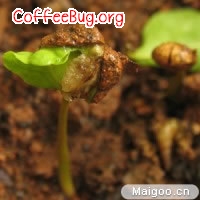In the process of coffee cultivation, coffee is grown with seeds with endocarp.
The cultivation process of Coffee
People often mistakenly think that coffee is grown directly with raw beans, but it takes a long time to grow coffee only to find that it doesn't sprout. In fact, coffee is grown with seeds with endocarp (Parchment). "Inner fruit" (or "sheepskin" or "paper skin") refers to the tea-brown hard skin that wraps the coffee seeds, and the coffee beans attached to that layer are called "Parchment Bean".

Plucking the skin of the fully ripe bright red coffee fruit (called red cherry), you can see that there is yellow flesh under the red skin, which is a bit like a cherry, the flesh is sweet, there is a pair of symmetrical seeds in the center, and there is a slippery film around the seeds. Wash the film off with water to become "shelled beans". Peel off the endocarp and you will see the seeds covered with Silver Skin. The seed is the raw bean actually used as the raw material of coffee.
1. Sowing seeds
The coffee wrapped with endocarp will be planted in the seedbed (a plastic flowerpot called "pot") and will germinate in 40 to 60 days and grow to about 50 centimeters in about 6 months after germination. At this stage, the seedlings are still fragile and must be covered with cold gauze and other things to block direct sunlight.
The seedlings blossomed about three years after they were transplanted from the seedbed to the garden. During this period, countries such as Central America that use hand-picking to harvest coffee beans will prune the branches of coffee trees and remove the lower side branches in order to improve the efficiency of harvesting coffee. The flowers of the coffee tree are white five-petal flowers with a jasmine scent. The flowers wither in a few days, then grow small fruits, and turn red in 6 to 8 months to represent maturity.
The peak of the coffee harvest is in the 6-10 years after the coffee tree grows, and then the harvest will gradually decline. In addition, if the coffee tree grows too high, it will also lead to a poor harvest, so coffee farmers will cut off the trunk from 30cm to 50cm above the ground, allowing it to regenerate branches and renew productivity. This step is called "Cutback". If combined with climate, fertilization, resistance to diseases and insect pests and other favorable conditions, coffee trees can last 20 years, or even 50 years of continuous fruit.
Wild coffee trees can be as high as 10 meters, but generally planted coffee trees are maintained at a height of about 2 meters in order to harvest conveniently. Arabica coffee varieties are being improved year after year, hoping to reach the level of high harvest, high virus resistance, early harvest, strong environmental adaptability, and, of course, the appropriate height of trees to make harvesting more efficient.
two。 Harvest
The harvest time and method of coffee vary from place to place, generally speaking, about once or twice a year (sometimes up to three or four times). The harvest time is mostly in the dry season. In Brazil, for example, around June, it starts in the north-eastern state of Bahia and ends in October in the southern state of Parana. The harvest period of Central American countries is from September to January of the following year, from lowlands to highlands.
Harvesting methods can be divided into two categories, one is hand picking method, the other is shaking method.
(1) hand picking
With the exception of Brazil and Ethiopia, most Arabica coffee-producing countries are harvested by hand. Hand picking involves not only picking ripe bright red coffee fruits, but also sometimes along with immature cyan coffee fruits and branches, so these immature beans are often mixed with refined coffee beans, especially when refined by natural methods. If these beans are mixed with baking, they will produce a disgusting stench.
(2) shake-down method
This method is to hit the ripe fruit or shake the coffee branch with a random stick, so that the fruit falls and accumulates into a pile. Larger estates will use large harvesters, while small and medium-sized farms will harvest with a sea of people mobilized by the whole family. This method of shaking the fruit off the ground is easier to mix with impurities and defective beans than the hand-picking method, and beans from some places can be stained with a strange smell or fermented because the ground is wet. Producers of Robusta coffee beans such as Brazil and Ethiopia are mostly harvested in this way.
Countries harvested by shaking and falling method also use natural drying method to refine coffee beans. Coffee blossoms in spring, bears fruit in summer and harvests in winter, so it is very difficult to harvest and dry in places where there is no clear distinction between drought and rainy seasons. in the rainy season, it is impossible to use natural drying. Therefore, coffee is suitable for growing in areas with distinct dry and rainy seasons.
Important Notice :
前街咖啡 FrontStreet Coffee has moved to new addredd:
FrontStreet Coffee Address: 315,Donghua East Road,GuangZhou
Tel:020 38364473
- Prev

Cultivation conditions of coffee "coffee belt" (Coffee Belt)
There is a noun called Coffee Belt. There are more than 60 coffee producing countries in the world, most of which are located in the tropics and subtropics between the Tropic of Cancer (latitude 2326). This coffee growing area is called a coffee belt or coffee area (Coffee Zone). The annual average temperature of the coffee belt is above 20 ℃, because the coffee tree is a tropical plant, and if the temperature is below 20 ℃,
- Next

Top 10 coffee boutiques in the world Panama Jade Geisha
Bourbon tips are unfamiliar to Chinese, but Japanese are crazy about this romantic, aromatic, semi-decaf coffee, which sells for as much as 8,400 yen per 100 grams in Japan. Discovered in Bourbon Island in 1810, the bean body has changed from round to pointed, unique lychee flavor and citrus fragrance, caffeine content is only half, but due to the amount of weak, it is the most valuable rare treasure. Panama
Related
- Detailed explanation of Jadeite planting Land in Panamanian Jadeite Manor introduction to the grading system of Jadeite competitive bidding, Red bid, Green bid and Rose Summer
- Story of Coffee planting in Brenka region of Costa Rica Stonehenge Manor anaerobic heavy honey treatment of flavor mouth
- What's on the barrel of Blue Mountain Coffee beans?
- Can American coffee also pull flowers? How to use hot American style to pull out a good-looking pattern?
- Can you make a cold extract with coffee beans? What is the right proportion for cold-extracted coffee formula?
- Indonesian PWN Gold Mandrine Coffee Origin Features Flavor How to Chong? Mandolin coffee is American.
- A brief introduction to the flavor characteristics of Brazilian yellow bourbon coffee beans
- What is the effect of different water quality on the flavor of cold-extracted coffee? What kind of water is best for brewing coffee?
- Why do you think of Rose Summer whenever you mention Panamanian coffee?
- Introduction to the characteristics of authentic blue mountain coffee bean producing areas? What is the CIB Coffee Authority in Jamaica?

